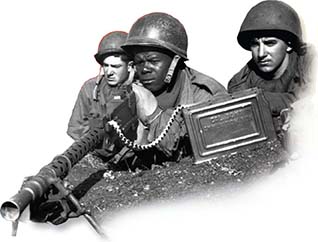SECTION 2: The Korean War

▲ American machine-gunners in Korea

Korean War Medal of Honor ►
WITNESS HISTORY  AUDIO
AUDIO
They Won’t Escape This Time
General Lewis B. Puller was the only U.S. marine in history to win five Navy Crosses. Since the time he enlisted in 1918, Puller had fought in Haiti and Nicaragua, commanded marines in China, and waded ashore island after island in the Pacific during World War II. Pinned down by a surprise communist Chinese attack into North Korea, badly outnumbered, and cut off from reinforcement, Puller retained his courage and humor. He informed his regiment:
“The enemy is in front of us, behind us, to the left of us, and to the right of us. They won’t escape this time.”
—Lewis “Chesty” Puller, November 1950
Objectives
- Explain how Mao Zedong and the communists gained power in China.
- Describe the causes and progress of the war in Korea.
- Identify the long-term effects of the Korean War.
Terms and People
- Jiang Jieshi
- Mao Zedong
- 38th parallel
- Douglas MacArthur
- limited war
- SEATO
NoteTaking
Reading Skill: Categorize As you read, note problems and the steps that President Truman took to solve them. Use a problem-solution table like the one below.
| Problem | Solution |
|---|---|
| Communists threaten takeover of China |
Why It Matters Europe had been the first focus of the Cold War. But in the early 1950s, U.S. involvement in the Korean War made East Asia the prime battleground in the long, hard Cold War struggle. The division between North and South Korea remains a source of international tension today. Section Focus Question: How did President Truman use the power of the presidency to limit the spread of communism in East Asia?
Communists Gain Control of China
Since the time of the Russian Revolution in 1917, the Soviets had hoped to spread communism to every corner of the world, training foreigners in Marxist theory and revolutionary strategy. The Soviets were confident that communism would reach worldwide influence. In 1949, events in China seemed to justify their confidence.
Civil War Divides China
Before Japan invaded China in 1937, Nationalist leader Jiang Jieshi (zhee AHNG zhī SHEE), known in the United States as Chiang Kai-shek, had been fighting a civil war against communists led by Mao Zedong (mow zeh DUHNG). Although Jiang and Mao temporarily joined forces in an uneasy alliance to fight Japan, the civil war resumed with a new fury after the war ended.
The Soviet Union supported Mao, while the United States sent several billion dollars in aid to Jiang. American leaders feared that Jiang’s defeat would create a communist superpower spanning most of Asia.
Jiang’s regime proved unequal to the task. Nationalist generals were reluctant to fight. And, while masses of Chinese people faced starvation, corrupt officials diverted U.S. aid dollars into their own pockets. By promising to feed the people, Mao won increased support.




